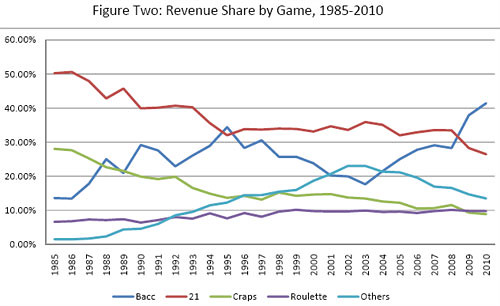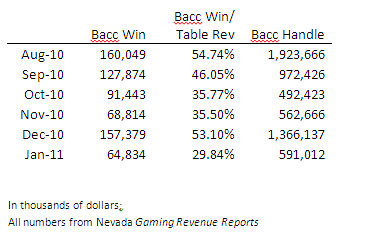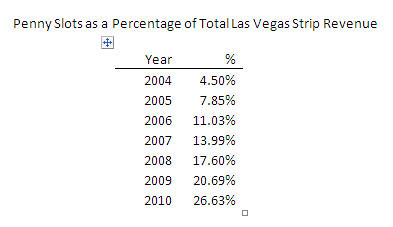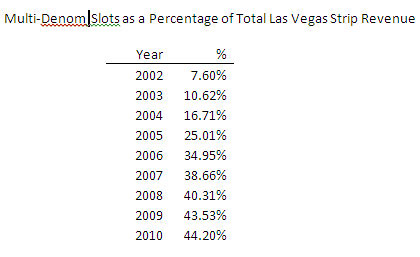Two Way Hard Three | Las Vegas Casino & Design Blog
Dr. Dave: Thoughts on Bacc & Pennies
Posted by daveschwartzLast week, one of the local dailies ran a story reporting on the latest trend: baccarat and penny slots are big revenue producers for casinos, particularly on the Las Vegas Strip.
Great story, but it's about 6 months out of date--at least where baccarat's concerned. And, as a look at the numbers will show, the ascendancy of the penny slot is hardly news. There's a real story in here, but it's not the one you read in the paper--and it's not necessarily a good one for Nevada gaming.
(More after the jump)
First, let's talk about baccarat. As a percentage of total Strip casino revenues, it's been on a tear, while gaming revenue in general has been slumping. It really carried the state for much of 2010.
To put the rise in baccarat into context, I'm going to borrow from a neat little report I wrote back in December about Las Vegas Strip Table Game Mix, 1985-2010 (pdf)
Note: for 2010, I used only the first 3 quarters of revenue data (that's all I had available at the time), so the 2010 number is actually a bit overstated, given how bacc fizzled in the 4th quarter, but I'm giving away the punchline. Here's a thousand words worth of explanation:
As you can see, baccarat's recent surge isn't entirely unprecedented. In the mid-1990s baccarat was similarly booming, actually out-earning blackjack on the Strip in 1995. After 9/11, international high-end play evaporated, though baccarat was already trending downward. The revival of baccarat began in 2004, though its bigger proportional share of gaming revenues is due, as many correctly believe, to the relative shrinking of other table game play during the recession.
But here's where it gets interesting. As of last September, everything in that article about baccarat's ascendancy is spot on. This was around the time that I coined the phrase "baccarat-based recovery," which a few other analysts have picked up. For much of 2010, it seemed that strong bacc play would paper over the decline in overall gambling in Las Vegas, provided there weren't any major swings in hold percentage.
Since then, however, it's been a totally different story. Baccarat's been on the decline, ending the "baccarat-based recovery." There's a reason why Nevada's had year-to-year decreases in gaming revenue for three months in a row now: less baccarat play. Here's a chart for the Las Vegas Strip that illuminates the decline in baccarat play since September.
Baccarat win is self-explanatory--it's how much Strip casinos won at the game. The next column is the baccarat win as a percentage of total table win--something that helps us see whether baccarat's powering an otherwise-stagnant market or just limping along. Finally, I included the baccarat handle, to show that this isn't just a case of unfavorable hold; there's much less baccarat play now than there was before.
Another scary number: January's baccarat revenue was the lowest since 2004--not a sign that we're trending upward.
So even though, on the whole, baccarat in 2010 was an interesting story, the real story here is the game's sudden decline. What's the reason, and what does it mean for Nevada's gaming industry? Are Asian high rollers sticking to Macau and Singapore? Are domestic high rollers staying home, too? Outside of the baccarat salons of the Strip, it's hard to tell.
The baccarat-based recovery was a weak enough turnaround from the recession, but without it, the picture looks much worse.
Next, it's true that pennies are on a roll, but this is not exactly breaking news in 2011. As the chart shows, pennies have been on the upswing for more than seven years:
When pennies re-emerged in 2004, it was a huge story. Historically, they had long been on the decline; back in 1994, there were only 169 of them in all of Nevada's casinos. They accounted for about one-tenth of one percent of total statewide slot revenues. In 1995, the state stopped reporting them as a distinct category, lumping them in with "others."
But when pennies came charging back in the mid-2000s, they were, as anyone who's been in a casino knows, machines that took more than a penny a spin. With the introduction of the credit meter and bill validators, as well as video screens, multi-line, multi-coin machines became the norm. Allowing players to wager as much as $5 a spin, and with considerably higher holds than higher denomination games (approximately 10% for pennies vs 5% for quarters), they immediately became big revenue producers.
So what makes the penny slot so newsworthy in March 2011? The article suggests that it's a reaction to the recession, but that's not entirely, if it all, the case: as you can see for yourself, the move to penny slots predates the recession. In fact, the year-to year increases in penny slot revenue were larger in 2005 (74%) and 2006 (41%) than 2008 (26%), 2009 (18%), and 2010 (29%).
Penny slots may continue to gain traction during the recession, but it's disingenuous to argue that this is because of the recession, since proportionally speaking their growth has slowed since the Strip's economic woes began, though it did pick up again last year.
And focusing on pennies obscures the real dominant player in Strip slots: the multi-denomination machine.
As you can see in that table, multi-denom slots are the real revenue giants on the Strip, accounting for nearly half of all slot revenues--about double the size of pennies' market share. They can include penny denoms, but the machine's hold percentage--which is typically under 6%--suggests they may be seeing more action at higher denoms.
Multi-denom machines are popular with casinos because they give them 3 or 4 machines for the price of one--why bother buying separate penny, nickel, quarter, and dollar machines when you can have them all in one cabinet?
The policy question this should have raised long ago is: Does this mean that casinos will be putting fewer slots on the floor? (judging from the numbers, the answer is a clear "yes.") If so, should the fee structure of slot machines, which is based on the number of machines on the floor, be adjusted so the state can maximize its tax revenues from machines? With the budget hole the state's in, this isn't a minor issue at all.
So penny slots and baccarat might not be the most interesting gaming revenue story in March 2011, but there's certainly no shortage of stories hovering around them--and many of those stories have serious implication for Nevada and the gaming industry.
Search
Categories
- About Vegas (38)
- ARIA (21)
- Atlantic City (49)
- Bellagio (90)
- Books (10)
- Boyd Gaming (57)
- Business of Gaming (870)
- Caesars/Harrah's (130)
- Casino Design (369)
- Casino Design Photo of the Week (12)
- CityCenter (158)
- Columbia Sussex (11)
- Condo-Hotels (15)
- Cosmopolitan (20)
- Detroit Casinos (10)
- Device Manufacturers and Games (6)
- Downtown Las Vegas (71)
- Dr. Dave Schwartz (68)
- Fontainebleau (30)
- Gaming Numbers (8)
- Genting (2)
- Interviews (13)
- iPhone (43)
- Landry's (1)
- Las Vegas Photography (98)
- Las Vegas Strip (740)
- Las Vegas/Casino History (3)
- Linq (4)
- Macau Casinos and Hotels (164)
- MGM Resorts International (418)
- Monte Carlo Fire (5)
- Online Gaming (2)
- Open Topics (20)
- Palazzo (59)
- Paolo Mello (1)
- Planet Hollywood (10)
- Podcasts (149)
- Poker (11)
- Press Releases (19)
- RateVegas.com (111)
- Reader Questions (3)
- Reader Reviews (54)
- Simpson on Vegas (38)
- SLS Las Vegas (2)
- Station Casinos (49)
- Strip Walk (32)
- Stripping (Reviews) (13)
- Travel (1)
- Trip Reports (95)
- Tropicana (4)
- Vegas Gang Podcast (115)
- Vegas Internet Mafia Picnic (7)
- Vegas Mate (21)
- Vegas Tips (9)
- Vegas Uncorked (6)
- VegasDelivered.com (1)
- Venetian/LV Sands (198)
- Video (9)
- Wynn Resorts (396)
Subscribe
- Grab our RSS Feed.
New to RSS? Learn more...
Recent Comments
- All Recent Comments on one page.
- Paco recently commented "The newspaper article is hopelessly out of date. It should have been news w..." in Dr. Dave: Thoughts on Bacc & Pennies
- socalduck recently commented "I've never seen the multi-denom % before, that was a real eye-opener. Give..." in Dr. Dave: Thoughts on Bacc & Pennies
- jinx recently commented "Parchedearth, my understanding is the hold on pennies can still varely wid..." in Dr. Dave: Thoughts on Bacc & Pennies
- mungroo recently commented "The baccarat rise and sudden fall is very interesting. You mention it in y..." in Dr. Dave: Thoughts on Bacc & Pennies
- Michael Lu recently commented "nice post dr. dave! personally i think the trend for baccarat is that it's ..." in Dr. Dave: Thoughts on Bacc & Pennies
- parchedearth recently commented "Does anyone know the hold % on the newer penny-slot machines or does it var..." in Dr. Dave: Thoughts on Bacc & Pennies
- Dave recently commented "^ Yeah, I've mentioned that the "baccarat-based recovery" isn't really much..." in Dr. Dave: Thoughts on Bacc & Pennies
- Jeff Simpson recently commented "Good numbers and analysis, Dr. Dave. My peeve with MSM coverage of last yea..." in Dr. Dave: Thoughts on Bacc & Pennies
- Dshort2727 recently commented "obviously, the advent of TITO made the penny slot viable. I remember playi..." in Dr. Dave: Thoughts on Bacc & Pennies
- Hunter recently commented "Just wanted to say welcome to Dave - so happy to have you doing some writin..." in Dr. Dave: Thoughts on Bacc & Pennies
Archives
- January 2018
- December 2012
- November 2012
- October 2012
- September 2012
- August 2012
- July 2012
- June 2012
- May 2012
- April 2012
- March 2012
- February 2012
- January 2012
- December 2011
- November 2011
- October 2011
- September 2011
- August 2011
- July 2011
- June 2011
- May 2011
- April 2011
- March 2011
- February 2011
- January 2011
- December 2010
- November 2010
- October 2010
- September 2010
- August 2010
- July 2010
- June 2010
- May 2010
- April 2010
- March 2010
- February 2010
- January 2010
- December 2009
- November 2009
- October 2009
- September 2009
- August 2009
- July 2009
- June 2009
- May 2009
- April 2009
- March 2009
- February 2009
- January 2009
- December 2008
- November 2008
- October 2008
- September 2008
- August 2008
- July 2008
- June 2008
- May 2008
- April 2008
- March 2008
- February 2008
- January 2008
- December 2007
- November 2007
- October 2007
- September 2007
- August 2007
- July 2007
- June 2007
- May 2007
- April 2007
- March 2007
- February 2007
- January 2007
- December 2006
- November 2006
- October 2006
- September 2006
- August 2006
- July 2006
- June 2006
- May 2006
- April 2006
- March 2006
- February 2006
- January 2006
- December 2005
- November 2005
- October 2005
- September 2005
- August 2005
- July 2005
- June 2005
- May 2005
- April 2005
- March 2005
- February 2005
- January 2005











Comments
Just wanted to say welcome to Dave - so happy to have you doing some writing here.
As far as slots on the floor, based on MWS' comments, I think we're for sure going to see some changes to the WLV slot floor - I believe she said that she believes they're not hitting their potential. Will be interesting to see how those potential changes are impacted by the above.
If Steve is 'The Steve', is Marilyn Winn Spiegel 'The Marilyn'? Not the same ring. We need a better nickname for the new Queen of Wynncore.
obviously, the advent of TITO made the penny slot viable. I remember playing at a downtown casino who had not TITO'd paying every penny cash out as a hand pay.
However, the main reason that I play pennies is that they are fun. And the rule of responsible gambling is that it should be entertainment.
Dan
Good numbers and analysis, Dr. Dave.
My peeve with MSM coverage of last year's baccarat surge was that they treated it like it was boosting the entire Strip and the state without looking more closely at where baccarat is played. First, the increase in win DOES help the state's tax receipts, but DOESN'T significantly help many casinos. All of the casinos outside of Clark County don't benefit and, in Clark Co., only a handful of Strip casinos (and operating companies) benefit. In fact, the two Wynn Resorts casinos, a couple of MGM casinos (Bellagio, Aria & sometimes MGM Grand) both Las Vegas Sands casinos and Caesars Palace are the only players of note in the baccarat business. So, when the combined state numbers are analyzed, the upswing in baccarat business that offset a continuing decline in blackjack and other table games was not a help to most non-baccarat casinos. Those non-baccarat casinos had another year of declining gaming revenue.
As for the rise of multi-denom machines, I believe the state needs to get rid of the category and have casinos report separately the numbers for the different denominations which are played on the multi-denom machines. The trend toward increasing use of multi-denom devices is so steady that it is obvious that it is becoming increasingly difficult to meaningfully analyze which denominations are really being played. The numbers should be broken down by denomination on those machines rather than aggregated, allowing better analysis of play by denomination.
^ Yeah, I've mentioned that the "baccarat-based recovery" isn't really much of a recovery in the past, too.
The question is, where do we go from here? I'm predicting there'll be respectable February because of Chinese New Year's, but after that, it's anyone's guess.
It'll be a tough comparison because February 2010 had about $1.2 in baccarat handle, which is pretty good, so I don't see much room for growth there. Combined with a 17% hold, that made Feb 2010 a real boom month for baccarat. If the hold's anywhere near normal, we'll probably see a fourth straight month of declining revenue--unless something else compensates.
Does anyone know the hold % on the newer penny-slot machines or does it vary widely? My understanding is that old-style penny slot machines had a pretty high hold compared to dollar machines, but you can play several dollars a spin on the new machines. I found one machine that was $20/spin! Some also have progressives which typically have a much higher hold. Is it possible for the hold to vary based on how many credits you are playing?
nice post dr. dave! personally i think the trend for baccarat is that it's going to get worse in vegas. with weak enforcement of title 31 and other money transaction logs, a lot of cash-only business owners like to spend their times in california card clubs. ez baccarat's popularity has been growing lately. i think people like these ridiculous long shot bets. http://labusinessjournal.com/news/2010/oct/04/big-deal/
The baccarat rise and sudden fall is very interesting. You mention it in your post, but the September 2010 decline on the Strip seems to coincide closely with the first big month from the Marina Bay Sands casino.
I assume that the baccarat action was coming from Asian whales primarily. I wonder if the MBS casino represents the turning point for Singapore and Macau (which really seems to have found its legs again) providing attractive enough destinations to keep the Asian action in Asia.
I dislike Singapore but that MBS resort is impressive enough to make me want to check it out in person.
Parchedearth, my understanding is the hold on pennies can still varely widely, but is set much higher then dollar machines still. I believe Wizard of odds used to do some breakdowns of estimated hold percentages and LVA has done some as well I believe.
I've never seen the multi-denom % before, that was a real eye-opener. Given all the hassles of traveling to the US, and the great options now available in Macau, Singapore and elsewhere, it would not be surprising to me if you continue to see Asian visitation decline in Las Vegas. Wynn is slowly repositioning the Vegas properties towards a domestic (non-baccarat) audience, while funneling the Asian play into Macau. Imagine what the Vegas bacc numbers will look like after Cotai gets up to speed.
The newspaper article is hopelessly out of date. It should have been news when baccarat was higher than blackjack in August 2009 (the first time since 1995).
After three straight months of baccarat decline, the significant question now is will competition with Marina Bay Sands drive baccarat back to pre-recession levels. While Steve Wynn still has some tax incentives to pull his whales to Vegas, Sheldon just needs to get them to Singapore. If you read LVSands reports, gaming at Venetian has been tumbling in Vegas since MBS opened.
------------
The penny slots seem to have peaked as well. Plus you can play penny slots anywhere. Who is going to fly to Vegas just to play penny slots?
=============
The lowest "running 12 month average" for the state is $10,284,499 set in June of 2010. When the February numbers are released, I think they will set a new low (for the state), because there is no way this Chinese New Year's is going to be as good as last year's.
The surge in "baccarat revenue" has been clouding the numbers for the last few years. These numbers were bought at high cost in comps and have resulted in very few jobs. With win percentages ranging from 17% to 3.5% a few months apart, the casinos are not going to hire people.